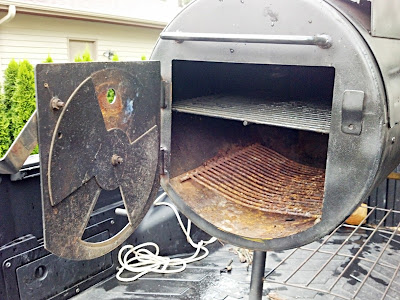Weather has been hot and muggy. It was 80° already when the meat went on. Wind is light at about 5 mph and the sky is overcast.
Both pieces of meat are getting a simple treatment with salt and pepper only. The brisket was just a bit too long to fit on the mini-WSM so I trimmed a triangle off the skinny end of the flat. I flipped this over and lay where I cut it and saw that the two pieces were about the same thickness of the other end of the brisket. I decided to cook it that way to see if that helped to get more even cooking overall. I also trimmed some of the fat off the brisket. the final disposition of this is that the fat side of the main piece was down and the fat side of the small triangle was fat side up. I spread a couple more pieces of the trimmed fat on the other parts of the brisket to render into the meat as it cooked.
The round had a fat side which I started down with some of the fat trimmed from the brisket spread over the upper surface.
The brisket is going on the mini-WSM with a foiled pan. I fired it with K-comp briquettes and and some oak, mesquite and apple. The lower vents were partially open and I just left them as they were. This will likely be a semi-high heat cook. The time/temperature profile below is for the brisket in the mini.
The round will be cooked in the 18" kettle where I used a single wire basket to hold Cowboy Lump (meant to use Mesquite lump but wasn't paying attention...) with some mesquite and apple for smoke. All vents are wide open. I used the lid from a Dutch oven as a drip pan under the round. About half an hour after firing this up and putting the meat on, a thermometer stuck through the lid vent read about 300°.
| time | temp | comment |
| 10:50 AM | Meat on! (Brisket, round went on about 15 minutes later.) | |
| 11:45 | 93°/331° (meat/cooker) | |
| 12:33 | 140°/309° | |
| 1:24 | 165°/203° | The cooker temperature makes no sense. I might have bumped the probe when I opened the cooker to check about half an hour ago. As long as the meat temp keeps going up. I'll leave it be. On last check, the kettle was running about 300° and the round looked good. Round measures 139° internal so it's coming off! |
| 1:43 | 174°/304° | Repositioned the cooker probe where it was not under the meat and could have meat juices dripping on it. |
| 2:45 | 187°/315° | |
| 3:51 | 199°/306° | Need to probe the brisket! Still pretty firm - letting it go a little longer. |
| 4:45 | 205°/300° | Meat off! Probing tender enough for me. ;) |
The bottom round came off first. I had planned to take it to 120° but the first time I checked it, it was already at 139°. I took it off then and covered with foil to rest. I captured the meat juices as it rested and added them to the drippings captured in the cast iron pan. To that I added about a cup or so of water and some beef soup base to make the au jus. I also added about a tablespoon of potato starch. The beef was still on the tough side, but I sliced it as thinly as possible and it made a decent Italian beef.
The brisket was very tasty. It was perhaps a bit on the dry side but not objectionably so. Tenderness was also good. The test of doubling up the thinnest portion seems to have worked well. I didn't think the thin end was overdone compared to the thick part.
The brisket was very tasty. It was perhaps a bit on the dry side but not objectionably so. Tenderness was also good. The test of doubling up the thinnest portion seems to have worked well. I didn't think the thin end was overdone compared to the thick part.
With the round, I might try a pot roast style cook with the meat sitting in juices while it smokes. Slicing (shaving off thin slices) is a fair bit of work. On the brisket, I would like to find a bigger one. Just over 6 lb was the biggest one they had at Sam's! I also really need to try wrapping it. I guess I should bite the bullet and buy some butcher paper at Sam's club so I can wrap just like Aaron.
Guilty pleasures ... The fat that I trimmed from the brisket and placed on the brisket and bottom round rendered and came out really good. :D
Guilty pleasures ... The fat that I trimmed from the brisket and placed on the brisket and bottom round rendered and came out really good. :D














